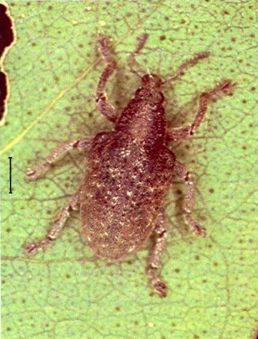PESTS AND DISEASES OF FORESTRY IN NEW ZEALAND
Gum tree weevil
Scion is the leading provider of forest-related knowledge in New Zealand
Formerly known as the Forest Research Institute, Scion has been a leader in research relating to forest health for over 50 years. The Rotorua-based Crown Research Institute continues to provide science that will protect all forests from damage caused by insect pests, pathogens and weeds. The information presented below arises from these research activities.
Forest and Timber Insects in New Zealand No. 8: Gum-tree weevil.
Revised 2009
Based on J. Bain (1977)
Insect: Gonipterus scutellatus Gyllenhal (Coleoptera: Curculionidae)

Fig. 1 - Gum-tree weevil. The line shows natural length.
Type of injury
Adults and larvae of the gum-tree weevil defoliate eucalypts. The adults prefer the leaf margin as a feeding site and this gives the leaves a scalloped appearance. They may also eat the soft bark of new shoots. The larvae feed over the whole leaf surface leaving only the hard fibres, and also eat the young shoots. Severe infestation can cause the trees to have a stunted appearance.
Hosts
The gum-tree weevil feeds on various species of Eucalyptus including E. eugenioides, E. fastigata, E. globulus, E. macarthurii, E. obliqua, and E. viminalis . Of these, E. globulus and E. viminalis appear to be favoured hosts. Narrow-leaved species such as E. pulchella are not usually attacked.
Distribution
This Australian insect is present throughout New Zealand. It was first recorded here in 1890.
Economic importance
Although the gum-tree weevil is now overshadowed by the eucalyptus tortoise beetle as a cause of damage, it is still regarded as an important defoliator of eucalypts.
Description, life history, and habits
The adult (Fig.1) is dull brownish-black and about 7-10 mm long. Blunt projections give a knobbly appearance to the front of the elytra (wing cases). The full-grown larva is plump, legless, pale yellowish-green with a dark stripe along each side, has many black spots on the back, and is rather slug-like in appearance (Fig.2).

Fig. 2 - Larvae of the gum-tree weevil.
There are usually two generations per year. From May to August the adults can be found hibernating under the loose bark of eucalypts, especially E. globulus. They emerge about September and move to the young foliage where the yellowish eggs are laid in small black cases about 3 mm long (Fig.3). Each case. contains from 7 to 16 eggs and the larvae emerge by eating their way directly through the leaf on which the case has been fixed. Egg-laying continues until about November. After the larvae have been feeding for a while they appear to have a black tail, but this "tail" is excrement projecting from the anus as a long black thread. The larval period usually lasts from four to five weeks and then the larvae fall to the ground to pupate in the soil. Adults emerge from the soil in December and January, and the cycle is repeated to produce a second generation of adults in March-April, which go into hibernation for the winter. In cooler districts (parts of the South Island) there is only one generation a year and the adults' which emerge December-January feed and then go into hibernation. Eggs are not laid until the following season.

Fig 3 - Egg cases of the gum-tree weevil
Control
In forest areas the gum-tree weevil is usually effectively controlled by an introduced egg parasite, Anaphes nitens (Girault). Should other control measures ever be necessary, sprays designed for leaf-feeding insects should prove effective.
Bibliography
Bain, J. 1977: Gonipterus scutellatus Gyllenhal (Coleoptera: Curculionidae). Gum-tree weevil. New Zealand Forest Service, Forest and Timber Insects in New Zealand No. 8.
Clark, A.F. 1938: A survey of the insect pests of eucalypts in New Zealand . New Zealand Journal of Science and Technology 19: 750-761.
Emberson, R.M. 1984. Forest and timber insects. In: Scott, R.R. (ed) New Zealand Pest and Beneficial Insects. Lincoln University, Canterbury, New Zealand. P 191-204.
This information is intended for general interest only. It is not intended to be a substitute for specific specialist advice on any matter and should not be relied on for that purpose. Scion will not be liable for any direct, indirect, incidental, special, consequential or exemplary damages, loss of profits, or any other intangible losses that result from using the information provided on this site.
(Scion is the trading name of the New Zealand Forest Research Institute Limited.)



